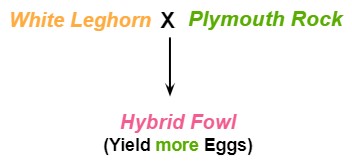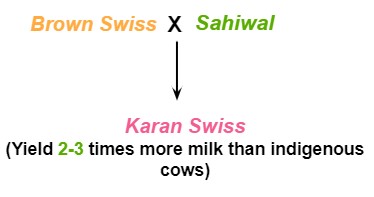
PUMPA - SMART LEARNING
எங்கள் ஆசிரியர்களுடன் 1-ஆன்-1 ஆலோசனை நேரத்தைப் பெறுங்கள். டாப்பர் ஆவதற்கு நாங்கள் பயிற்சி அளிப்போம்
Book Free DemoIn this theory, let us see what is outbreeding, the types of outbreeding and heterosis.
2. Outbreeding:
Outbreeding is the breeding of unrelated animals. The offspring formed are called hybrids.
The hybrids are stronger and vigorous than their parents. A cross between two different species with desirable features of economic value is mated.
Outbreeding can be:
- Between the individuals of the same breed (but not having common ancestors) - Outcrossing.
- Between different breeds - Cross-breeding.
- Between different species - Interspecific hybridization.

Types of outbreeding
A. Outcrossing:
Mating animals within the same breed but not having any common ancestors up to 4 - 6 generations. The offspring generated is called an outcross. It is done for animals that are below average in productivity in milk production and growth rate.
B. Cross-breeding:
Superior males of one breed are crossed with superior females of another breed. New animal breeds have been developed through cross-breeding. Through this method, cows of the inferiorbreed are mated to bulls of the superior breed to obtain better progeny.
Example:
Bikaneri (Magra) ewes and Australian Marino rams were crossed to develop a new sheep breed, Hissardale, in Punjab.
i. Cross-breeding of fowls:
A hybrid fowl is obtained by cross-breeding White Leghorn and Plymouth rock that yield more eggs.

ii. Cross-breeding of cows:
Cross-breeding of cows is accomplished by mating indigenous cow breeds with bulls of exotic breeds. An example is the mating of Brown Swiss with Sahiwal to produce progeny - Karan Swiss. Karan swiss yields two to three times more milk than the indigenous breeds.

C. Interspecific hybridization:
Male and female animals of two different species are mated, and the progeny obtained are different from that of the parents. The progeny may combine the desirable characteristics of both parents. Now, let us see an example of interspecific hybridization.
Mule is produced from a cross between the female horse (mare) and a male donkey. They are superior to the horse in strength, intelligence, well suited for hard work in mountain regions, and resistant to diseases but are sterile.

Mule produced by cross breeding
A video about animal husbandry and the types of animal breeding:
Heterosis:
The superiority of the hybrid obtained by cross-breeding is called as heterosis or hybrid vigour.
1. Increased milk production by cattle.
2. Increased production of eggs by poultry.
3. High grade or high-quality meat is produced.
4. Increased growth rate in domesticated animals.
Reference:
https://www.pxfuel.com/en/free-photo-xhsta/download
https://www.youtube.com/watch?v=3agp4U61TaQ